Corporate and Financial Accounting
VerifiedAdded on 2023/06/11
|13
|2889
|277
AI Summary
This report discusses CSR Limited's financial information and environmental initiatives. It covers the qualitative characteristics of financial information, the disclosure of environmental initiatives, and factors to consider during consolidation. The report also provides recommendations for CSR Limited. Course code, course name, and college/university are not mentioned.
Contribute Materials
Your contribution can guide someone’s learning journey. Share your
documents today.
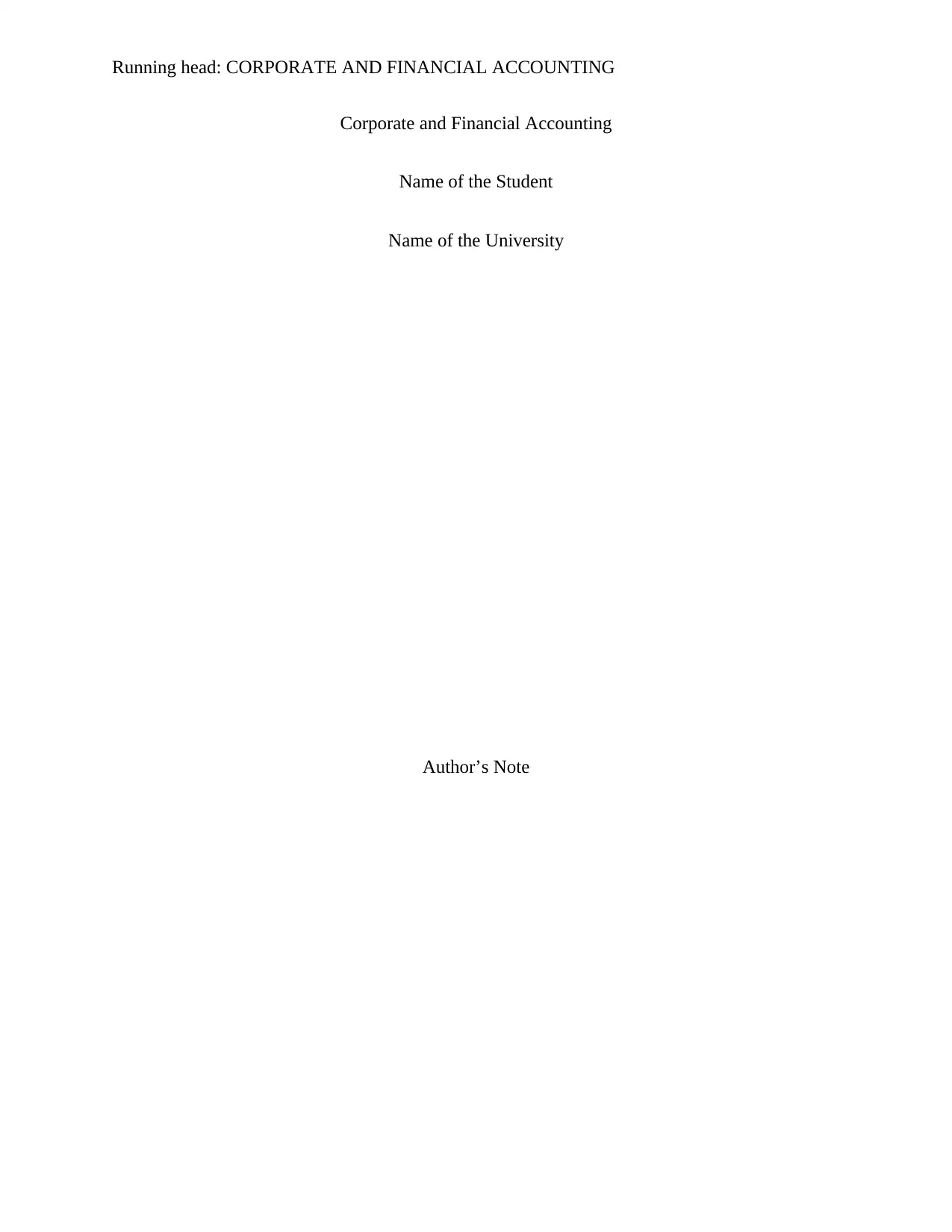
Running head: CORPORATE AND FINANCIAL ACCOUNTING
Corporate and Financial Accounting
Name of the Student
Name of the University
Author’s Note
Corporate and Financial Accounting
Name of the Student
Name of the University
Author’s Note
Secure Best Marks with AI Grader
Need help grading? Try our AI Grader for instant feedback on your assignments.
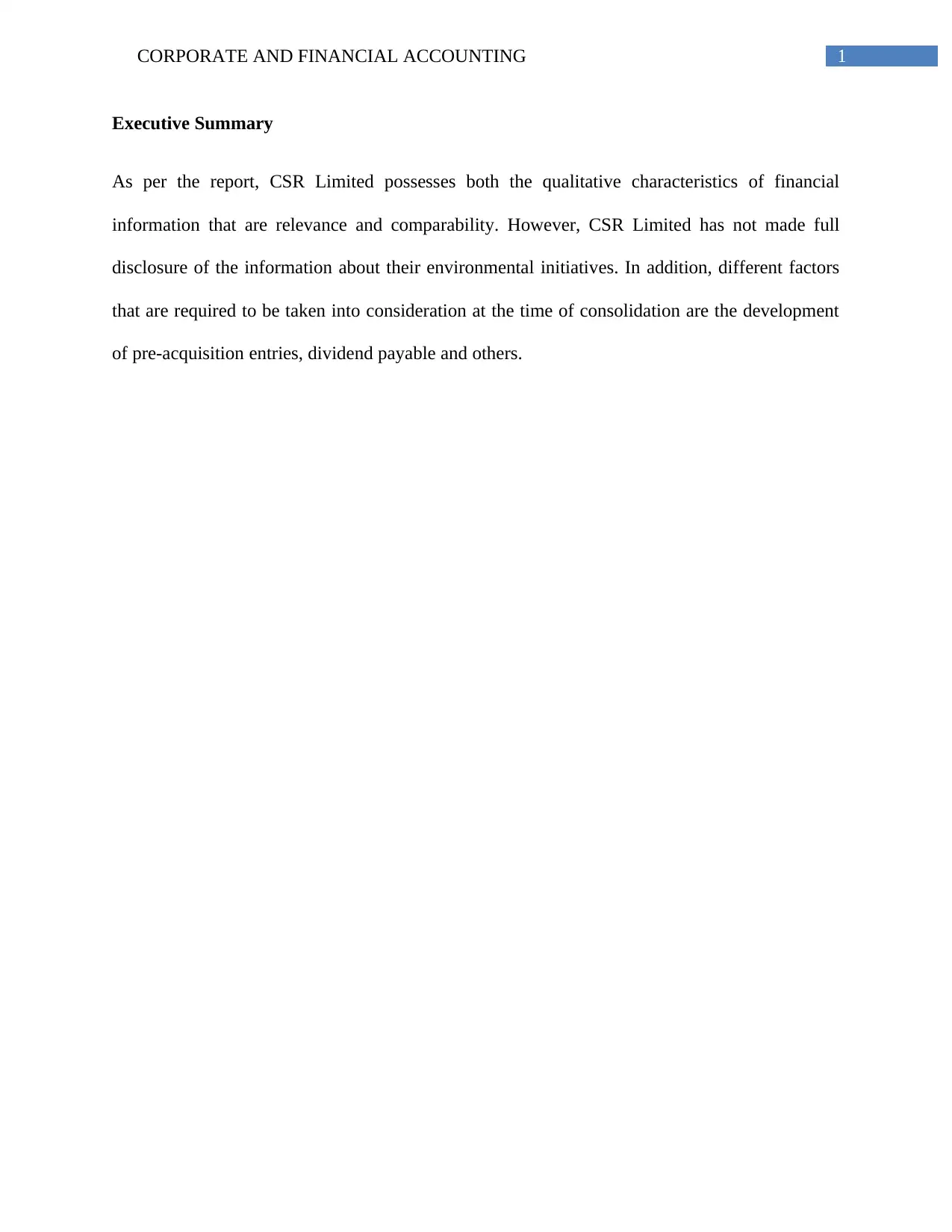
1CORPORATE AND FINANCIAL ACCOUNTING
Executive Summary
As per the report, CSR Limited possesses both the qualitative characteristics of financial
information that are relevance and comparability. However, CSR Limited has not made full
disclosure of the information about their environmental initiatives. In addition, different factors
that are required to be taken into consideration at the time of consolidation are the development
of pre-acquisition entries, dividend payable and others.
Executive Summary
As per the report, CSR Limited possesses both the qualitative characteristics of financial
information that are relevance and comparability. However, CSR Limited has not made full
disclosure of the information about their environmental initiatives. In addition, different factors
that are required to be taken into consideration at the time of consolidation are the development
of pre-acquisition entries, dividend payable and others.
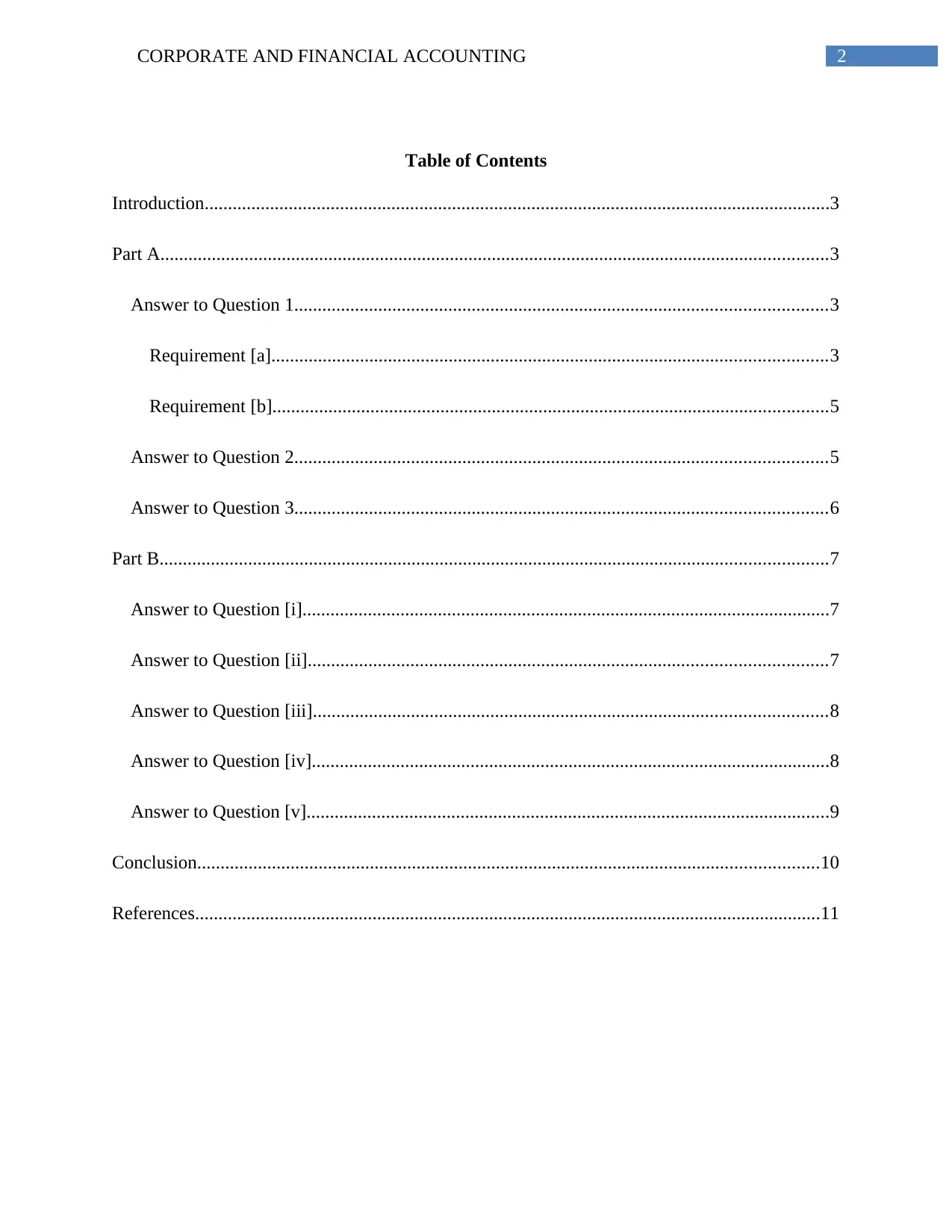
2CORPORATE AND FINANCIAL ACCOUNTING
Table of Contents
Introduction......................................................................................................................................3
Part A...............................................................................................................................................3
Answer to Question 1..................................................................................................................3
Requirement [a].......................................................................................................................3
Requirement [b].......................................................................................................................5
Answer to Question 2..................................................................................................................5
Answer to Question 3..................................................................................................................6
Part B...............................................................................................................................................7
Answer to Question [i].................................................................................................................7
Answer to Question [ii]...............................................................................................................7
Answer to Question [iii]..............................................................................................................8
Answer to Question [iv]...............................................................................................................8
Answer to Question [v]................................................................................................................9
Conclusion.....................................................................................................................................10
References......................................................................................................................................11
Table of Contents
Introduction......................................................................................................................................3
Part A...............................................................................................................................................3
Answer to Question 1..................................................................................................................3
Requirement [a].......................................................................................................................3
Requirement [b].......................................................................................................................5
Answer to Question 2..................................................................................................................5
Answer to Question 3..................................................................................................................6
Part B...............................................................................................................................................7
Answer to Question [i].................................................................................................................7
Answer to Question [ii]...............................................................................................................7
Answer to Question [iii]..............................................................................................................8
Answer to Question [iv]...............................................................................................................8
Answer to Question [v]................................................................................................................9
Conclusion.....................................................................................................................................10
References......................................................................................................................................11
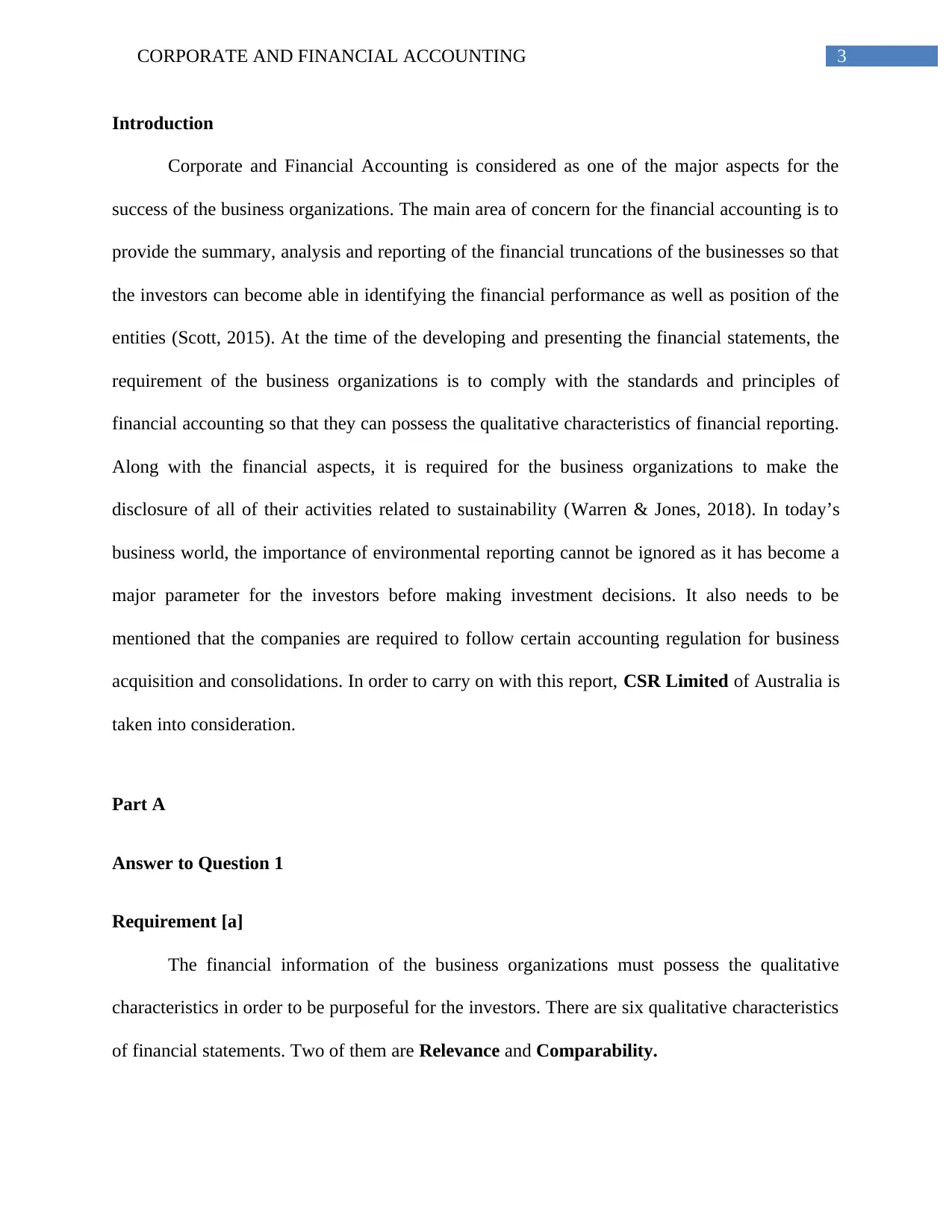
3CORPORATE AND FINANCIAL ACCOUNTING
Introduction
Corporate and Financial Accounting is considered as one of the major aspects for the
success of the business organizations. The main area of concern for the financial accounting is to
provide the summary, analysis and reporting of the financial truncations of the businesses so that
the investors can become able in identifying the financial performance as well as position of the
entities (Scott, 2015). At the time of the developing and presenting the financial statements, the
requirement of the business organizations is to comply with the standards and principles of
financial accounting so that they can possess the qualitative characteristics of financial reporting.
Along with the financial aspects, it is required for the business organizations to make the
disclosure of all of their activities related to sustainability (Warren & Jones, 2018). In today’s
business world, the importance of environmental reporting cannot be ignored as it has become a
major parameter for the investors before making investment decisions. It also needs to be
mentioned that the companies are required to follow certain accounting regulation for business
acquisition and consolidations. In order to carry on with this report, CSR Limited of Australia is
taken into consideration.
Part A
Answer to Question 1
Requirement [a]
The financial information of the business organizations must possess the qualitative
characteristics in order to be purposeful for the investors. There are six qualitative characteristics
of financial statements. Two of them are Relevance and Comparability.
Introduction
Corporate and Financial Accounting is considered as one of the major aspects for the
success of the business organizations. The main area of concern for the financial accounting is to
provide the summary, analysis and reporting of the financial truncations of the businesses so that
the investors can become able in identifying the financial performance as well as position of the
entities (Scott, 2015). At the time of the developing and presenting the financial statements, the
requirement of the business organizations is to comply with the standards and principles of
financial accounting so that they can possess the qualitative characteristics of financial reporting.
Along with the financial aspects, it is required for the business organizations to make the
disclosure of all of their activities related to sustainability (Warren & Jones, 2018). In today’s
business world, the importance of environmental reporting cannot be ignored as it has become a
major parameter for the investors before making investment decisions. It also needs to be
mentioned that the companies are required to follow certain accounting regulation for business
acquisition and consolidations. In order to carry on with this report, CSR Limited of Australia is
taken into consideration.
Part A
Answer to Question 1
Requirement [a]
The financial information of the business organizations must possess the qualitative
characteristics in order to be purposeful for the investors. There are six qualitative characteristics
of financial statements. Two of them are Relevance and Comparability.
Secure Best Marks with AI Grader
Need help grading? Try our AI Grader for instant feedback on your assignments.
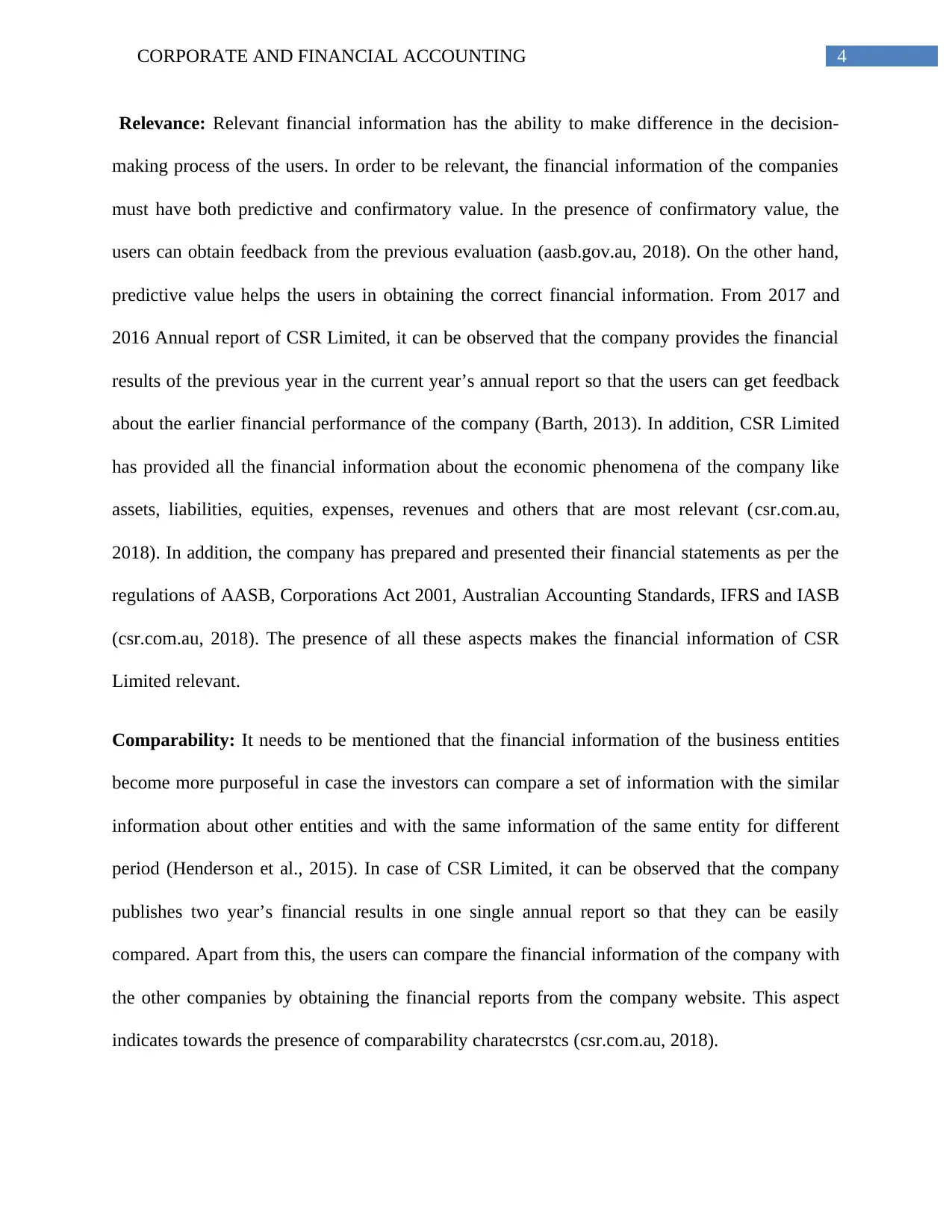
4CORPORATE AND FINANCIAL ACCOUNTING
Relevance: Relevant financial information has the ability to make difference in the decision-
making process of the users. In order to be relevant, the financial information of the companies
must have both predictive and confirmatory value. In the presence of confirmatory value, the
users can obtain feedback from the previous evaluation (aasb.gov.au, 2018). On the other hand,
predictive value helps the users in obtaining the correct financial information. From 2017 and
2016 Annual report of CSR Limited, it can be observed that the company provides the financial
results of the previous year in the current year’s annual report so that the users can get feedback
about the earlier financial performance of the company (Barth, 2013). In addition, CSR Limited
has provided all the financial information about the economic phenomena of the company like
assets, liabilities, equities, expenses, revenues and others that are most relevant (csr.com.au,
2018). In addition, the company has prepared and presented their financial statements as per the
regulations of AASB, Corporations Act 2001, Australian Accounting Standards, IFRS and IASB
(csr.com.au, 2018). The presence of all these aspects makes the financial information of CSR
Limited relevant.
Comparability: It needs to be mentioned that the financial information of the business entities
become more purposeful in case the investors can compare a set of information with the similar
information about other entities and with the same information of the same entity for different
period (Henderson et al., 2015). In case of CSR Limited, it can be observed that the company
publishes two year’s financial results in one single annual report so that they can be easily
compared. Apart from this, the users can compare the financial information of the company with
the other companies by obtaining the financial reports from the company website. This aspect
indicates towards the presence of comparability charatecrstcs (csr.com.au, 2018).
Relevance: Relevant financial information has the ability to make difference in the decision-
making process of the users. In order to be relevant, the financial information of the companies
must have both predictive and confirmatory value. In the presence of confirmatory value, the
users can obtain feedback from the previous evaluation (aasb.gov.au, 2018). On the other hand,
predictive value helps the users in obtaining the correct financial information. From 2017 and
2016 Annual report of CSR Limited, it can be observed that the company provides the financial
results of the previous year in the current year’s annual report so that the users can get feedback
about the earlier financial performance of the company (Barth, 2013). In addition, CSR Limited
has provided all the financial information about the economic phenomena of the company like
assets, liabilities, equities, expenses, revenues and others that are most relevant (csr.com.au,
2018). In addition, the company has prepared and presented their financial statements as per the
regulations of AASB, Corporations Act 2001, Australian Accounting Standards, IFRS and IASB
(csr.com.au, 2018). The presence of all these aspects makes the financial information of CSR
Limited relevant.
Comparability: It needs to be mentioned that the financial information of the business entities
become more purposeful in case the investors can compare a set of information with the similar
information about other entities and with the same information of the same entity for different
period (Henderson et al., 2015). In case of CSR Limited, it can be observed that the company
publishes two year’s financial results in one single annual report so that they can be easily
compared. Apart from this, the users can compare the financial information of the company with
the other companies by obtaining the financial reports from the company website. This aspect
indicates towards the presence of comparability charatecrstcs (csr.com.au, 2018).
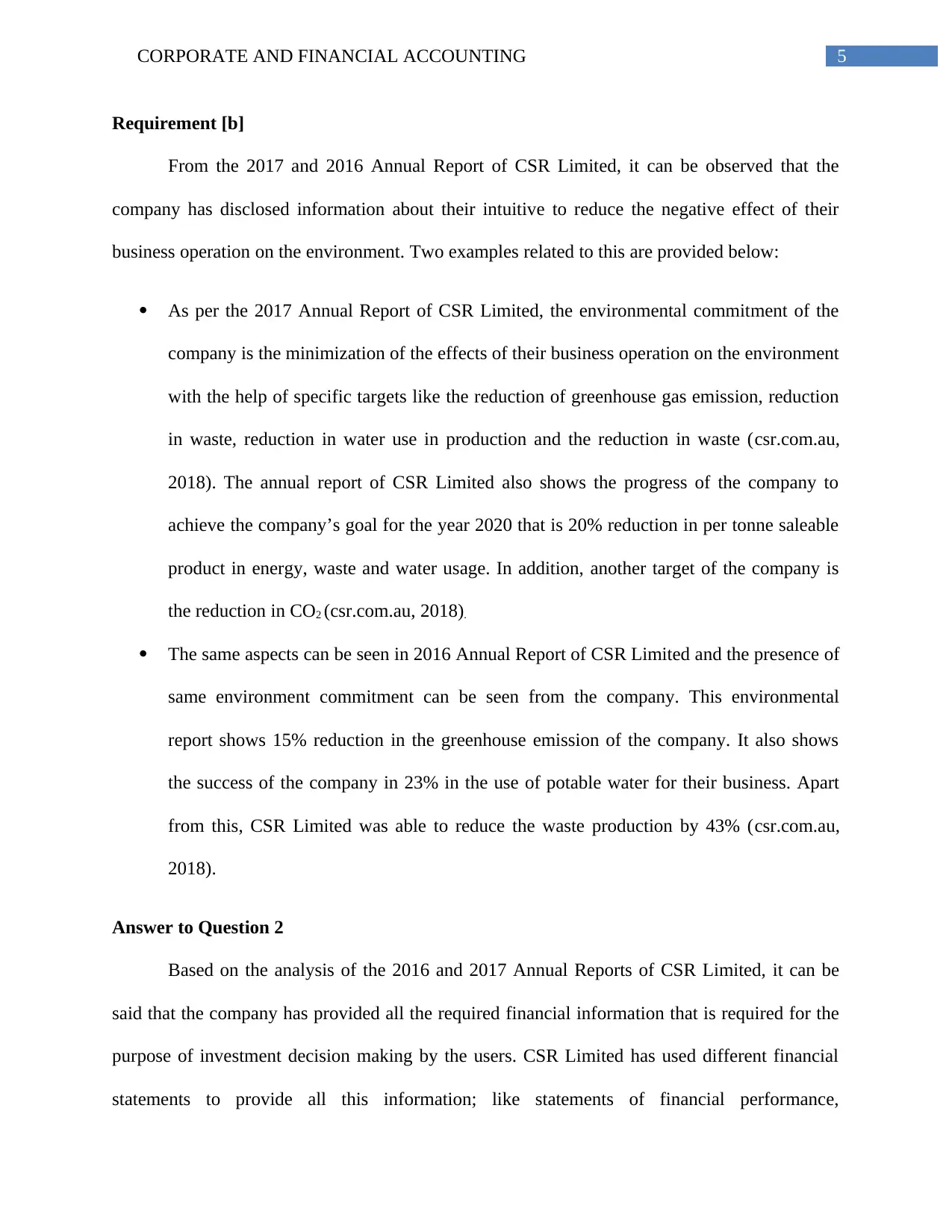
5CORPORATE AND FINANCIAL ACCOUNTING
Requirement [b]
From the 2017 and 2016 Annual Report of CSR Limited, it can be observed that the
company has disclosed information about their intuitive to reduce the negative effect of their
business operation on the environment. Two examples related to this are provided below:
As per the 2017 Annual Report of CSR Limited, the environmental commitment of the
company is the minimization of the effects of their business operation on the environment
with the help of specific targets like the reduction of greenhouse gas emission, reduction
in waste, reduction in water use in production and the reduction in waste (csr.com.au,
2018). The annual report of CSR Limited also shows the progress of the company to
achieve the company’s goal for the year 2020 that is 20% reduction in per tonne saleable
product in energy, waste and water usage. In addition, another target of the company is
the reduction in CO2 (csr.com.au, 2018).
The same aspects can be seen in 2016 Annual Report of CSR Limited and the presence of
same environment commitment can be seen from the company. This environmental
report shows 15% reduction in the greenhouse emission of the company. It also shows
the success of the company in 23% in the use of potable water for their business. Apart
from this, CSR Limited was able to reduce the waste production by 43% (csr.com.au,
2018).
Answer to Question 2
Based on the analysis of the 2016 and 2017 Annual Reports of CSR Limited, it can be
said that the company has provided all the required financial information that is required for the
purpose of investment decision making by the users. CSR Limited has used different financial
statements to provide all this information; like statements of financial performance,
Requirement [b]
From the 2017 and 2016 Annual Report of CSR Limited, it can be observed that the
company has disclosed information about their intuitive to reduce the negative effect of their
business operation on the environment. Two examples related to this are provided below:
As per the 2017 Annual Report of CSR Limited, the environmental commitment of the
company is the minimization of the effects of their business operation on the environment
with the help of specific targets like the reduction of greenhouse gas emission, reduction
in waste, reduction in water use in production and the reduction in waste (csr.com.au,
2018). The annual report of CSR Limited also shows the progress of the company to
achieve the company’s goal for the year 2020 that is 20% reduction in per tonne saleable
product in energy, waste and water usage. In addition, another target of the company is
the reduction in CO2 (csr.com.au, 2018).
The same aspects can be seen in 2016 Annual Report of CSR Limited and the presence of
same environment commitment can be seen from the company. This environmental
report shows 15% reduction in the greenhouse emission of the company. It also shows
the success of the company in 23% in the use of potable water for their business. Apart
from this, CSR Limited was able to reduce the waste production by 43% (csr.com.au,
2018).
Answer to Question 2
Based on the analysis of the 2016 and 2017 Annual Reports of CSR Limited, it can be
said that the company has provided all the required financial information that is required for the
purpose of investment decision making by the users. CSR Limited has used different financial
statements to provide all this information; like statements of financial performance,
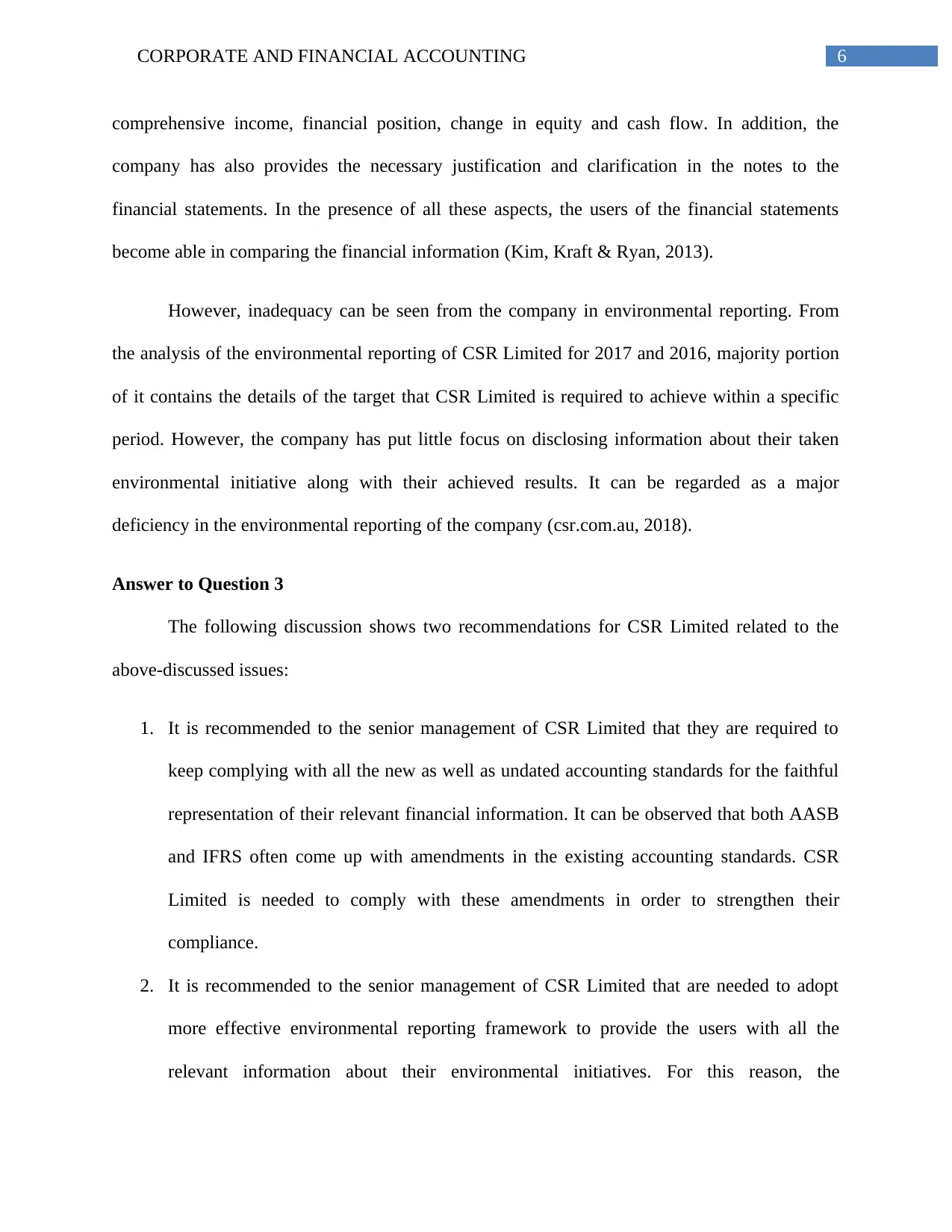
6CORPORATE AND FINANCIAL ACCOUNTING
comprehensive income, financial position, change in equity and cash flow. In addition, the
company has also provides the necessary justification and clarification in the notes to the
financial statements. In the presence of all these aspects, the users of the financial statements
become able in comparing the financial information (Kim, Kraft & Ryan, 2013).
However, inadequacy can be seen from the company in environmental reporting. From
the analysis of the environmental reporting of CSR Limited for 2017 and 2016, majority portion
of it contains the details of the target that CSR Limited is required to achieve within a specific
period. However, the company has put little focus on disclosing information about their taken
environmental initiative along with their achieved results. It can be regarded as a major
deficiency in the environmental reporting of the company (csr.com.au, 2018).
Answer to Question 3
The following discussion shows two recommendations for CSR Limited related to the
above-discussed issues:
1. It is recommended to the senior management of CSR Limited that they are required to
keep complying with all the new as well as undated accounting standards for the faithful
representation of their relevant financial information. It can be observed that both AASB
and IFRS often come up with amendments in the existing accounting standards. CSR
Limited is needed to comply with these amendments in order to strengthen their
compliance.
2. It is recommended to the senior management of CSR Limited that are needed to adopt
more effective environmental reporting framework to provide the users with all the
relevant information about their environmental initiatives. For this reason, the
comprehensive income, financial position, change in equity and cash flow. In addition, the
company has also provides the necessary justification and clarification in the notes to the
financial statements. In the presence of all these aspects, the users of the financial statements
become able in comparing the financial information (Kim, Kraft & Ryan, 2013).
However, inadequacy can be seen from the company in environmental reporting. From
the analysis of the environmental reporting of CSR Limited for 2017 and 2016, majority portion
of it contains the details of the target that CSR Limited is required to achieve within a specific
period. However, the company has put little focus on disclosing information about their taken
environmental initiative along with their achieved results. It can be regarded as a major
deficiency in the environmental reporting of the company (csr.com.au, 2018).
Answer to Question 3
The following discussion shows two recommendations for CSR Limited related to the
above-discussed issues:
1. It is recommended to the senior management of CSR Limited that they are required to
keep complying with all the new as well as undated accounting standards for the faithful
representation of their relevant financial information. It can be observed that both AASB
and IFRS often come up with amendments in the existing accounting standards. CSR
Limited is needed to comply with these amendments in order to strengthen their
compliance.
2. It is recommended to the senior management of CSR Limited that are needed to adopt
more effective environmental reporting framework to provide the users with all the
relevant information about their environmental initiatives. For this reason, the
Paraphrase This Document
Need a fresh take? Get an instant paraphrase of this document with our AI Paraphraser
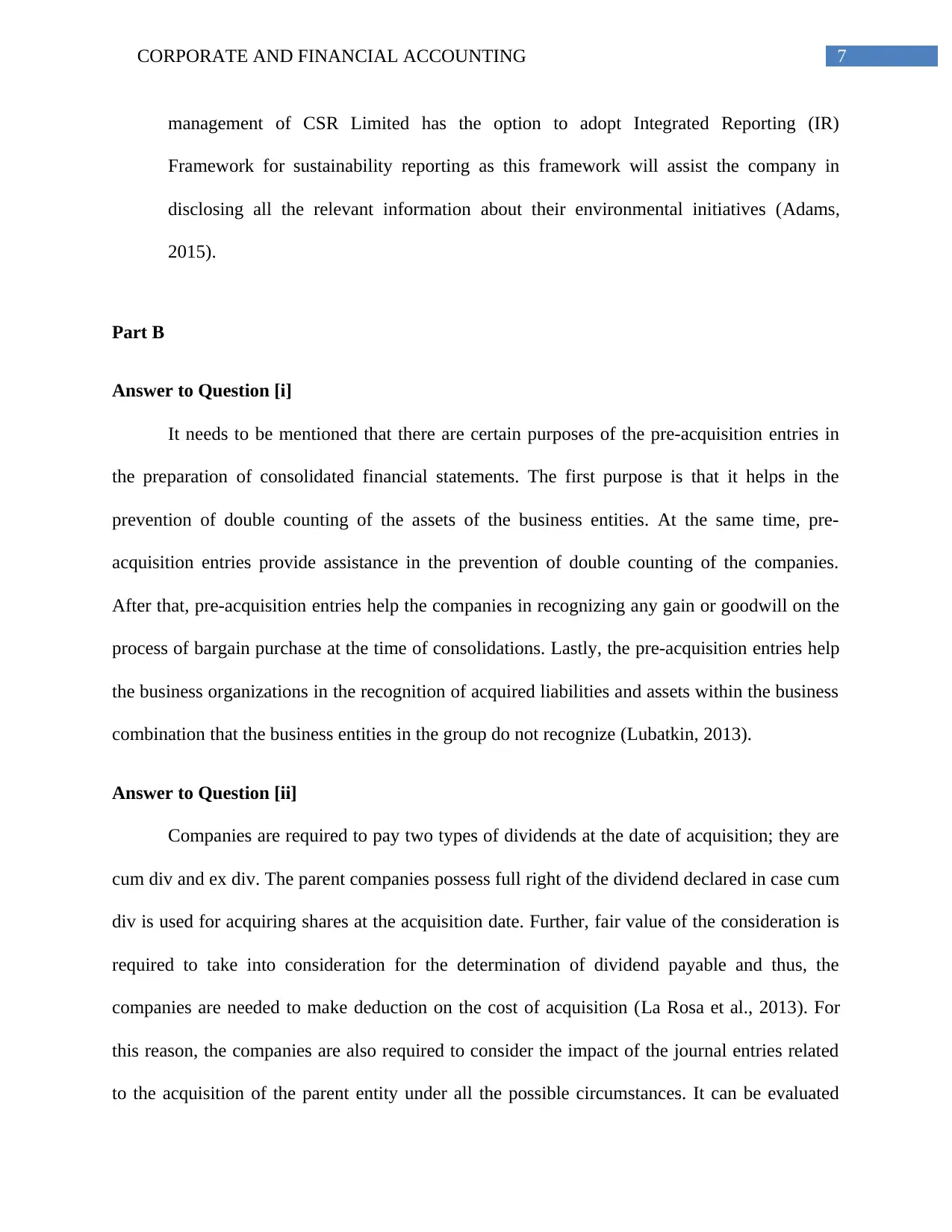
7CORPORATE AND FINANCIAL ACCOUNTING
management of CSR Limited has the option to adopt Integrated Reporting (IR)
Framework for sustainability reporting as this framework will assist the company in
disclosing all the relevant information about their environmental initiatives (Adams,
2015).
Part B
Answer to Question [i]
It needs to be mentioned that there are certain purposes of the pre-acquisition entries in
the preparation of consolidated financial statements. The first purpose is that it helps in the
prevention of double counting of the assets of the business entities. At the same time, pre-
acquisition entries provide assistance in the prevention of double counting of the companies.
After that, pre-acquisition entries help the companies in recognizing any gain or goodwill on the
process of bargain purchase at the time of consolidations. Lastly, the pre-acquisition entries help
the business organizations in the recognition of acquired liabilities and assets within the business
combination that the business entities in the group do not recognize (Lubatkin, 2013).
Answer to Question [ii]
Companies are required to pay two types of dividends at the date of acquisition; they are
cum div and ex div. The parent companies possess full right of the dividend declared in case cum
div is used for acquiring shares at the acquisition date. Further, fair value of the consideration is
required to take into consideration for the determination of dividend payable and thus, the
companies are needed to make deduction on the cost of acquisition (La Rosa et al., 2013). For
this reason, the companies are also required to consider the impact of the journal entries related
to the acquisition of the parent entity under all the possible circumstances. It can be evaluated
management of CSR Limited has the option to adopt Integrated Reporting (IR)
Framework for sustainability reporting as this framework will assist the company in
disclosing all the relevant information about their environmental initiatives (Adams,
2015).
Part B
Answer to Question [i]
It needs to be mentioned that there are certain purposes of the pre-acquisition entries in
the preparation of consolidated financial statements. The first purpose is that it helps in the
prevention of double counting of the assets of the business entities. At the same time, pre-
acquisition entries provide assistance in the prevention of double counting of the companies.
After that, pre-acquisition entries help the companies in recognizing any gain or goodwill on the
process of bargain purchase at the time of consolidations. Lastly, the pre-acquisition entries help
the business organizations in the recognition of acquired liabilities and assets within the business
combination that the business entities in the group do not recognize (Lubatkin, 2013).
Answer to Question [ii]
Companies are required to pay two types of dividends at the date of acquisition; they are
cum div and ex div. The parent companies possess full right of the dividend declared in case cum
div is used for acquiring shares at the acquisition date. Further, fair value of the consideration is
required to take into consideration for the determination of dividend payable and thus, the
companies are needed to make deduction on the cost of acquisition (La Rosa et al., 2013). For
this reason, the companies are also required to consider the impact of the journal entries related
to the acquisition of the parent entity under all the possible circumstances. It can be evaluated
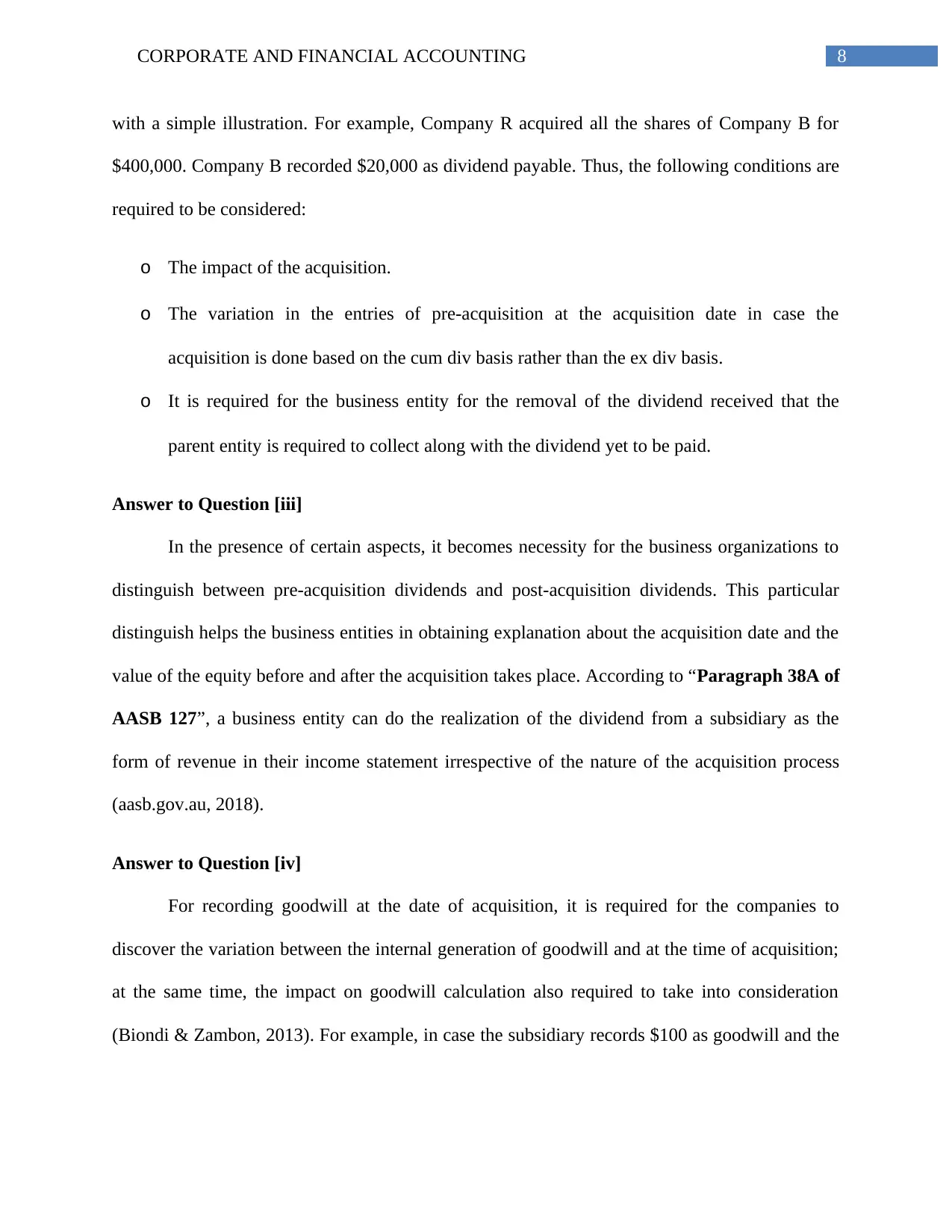
8CORPORATE AND FINANCIAL ACCOUNTING
with a simple illustration. For example, Company R acquired all the shares of Company B for
$400,000. Company B recorded $20,000 as dividend payable. Thus, the following conditions are
required to be considered:
o The impact of the acquisition.
o The variation in the entries of pre-acquisition at the acquisition date in case the
acquisition is done based on the cum div basis rather than the ex div basis.
o It is required for the business entity for the removal of the dividend received that the
parent entity is required to collect along with the dividend yet to be paid.
Answer to Question [iii]
In the presence of certain aspects, it becomes necessity for the business organizations to
distinguish between pre-acquisition dividends and post-acquisition dividends. This particular
distinguish helps the business entities in obtaining explanation about the acquisition date and the
value of the equity before and after the acquisition takes place. According to “Paragraph 38A of
AASB 127”, a business entity can do the realization of the dividend from a subsidiary as the
form of revenue in their income statement irrespective of the nature of the acquisition process
(aasb.gov.au, 2018).
Answer to Question [iv]
For recording goodwill at the date of acquisition, it is required for the companies to
discover the variation between the internal generation of goodwill and at the time of acquisition;
at the same time, the impact on goodwill calculation also required to take into consideration
(Biondi & Zambon, 2013). For example, in case the subsidiary records $100 as goodwill and the
with a simple illustration. For example, Company R acquired all the shares of Company B for
$400,000. Company B recorded $20,000 as dividend payable. Thus, the following conditions are
required to be considered:
o The impact of the acquisition.
o The variation in the entries of pre-acquisition at the acquisition date in case the
acquisition is done based on the cum div basis rather than the ex div basis.
o It is required for the business entity for the removal of the dividend received that the
parent entity is required to collect along with the dividend yet to be paid.
Answer to Question [iii]
In the presence of certain aspects, it becomes necessity for the business organizations to
distinguish between pre-acquisition dividends and post-acquisition dividends. This particular
distinguish helps the business entities in obtaining explanation about the acquisition date and the
value of the equity before and after the acquisition takes place. According to “Paragraph 38A of
AASB 127”, a business entity can do the realization of the dividend from a subsidiary as the
form of revenue in their income statement irrespective of the nature of the acquisition process
(aasb.gov.au, 2018).
Answer to Question [iv]
For recording goodwill at the date of acquisition, it is required for the companies to
discover the variation between the internal generation of goodwill and at the time of acquisition;
at the same time, the impact on goodwill calculation also required to take into consideration
(Biondi & Zambon, 2013). For example, in case the subsidiary records $100 as goodwill and the
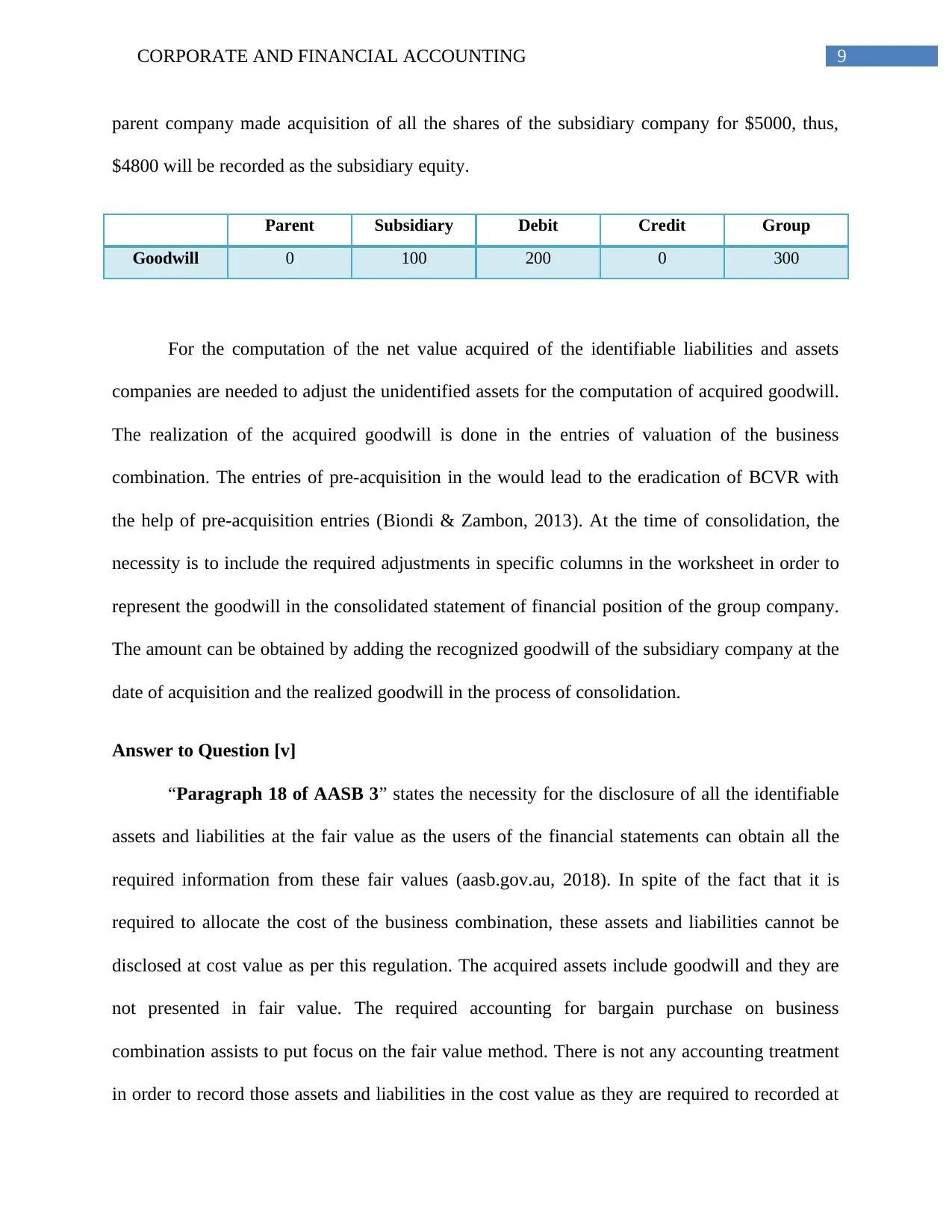
9CORPORATE AND FINANCIAL ACCOUNTING
parent company made acquisition of all the shares of the subsidiary company for $5000, thus,
$4800 will be recorded as the subsidiary equity.
Parent Subsidiary Debit Credit Group
Goodwill 0 100 200 0 300
For the computation of the net value acquired of the identifiable liabilities and assets
companies are needed to adjust the unidentified assets for the computation of acquired goodwill.
The realization of the acquired goodwill is done in the entries of valuation of the business
combination. The entries of pre-acquisition in the would lead to the eradication of BCVR with
the help of pre-acquisition entries (Biondi & Zambon, 2013). At the time of consolidation, the
necessity is to include the required adjustments in specific columns in the worksheet in order to
represent the goodwill in the consolidated statement of financial position of the group company.
The amount can be obtained by adding the recognized goodwill of the subsidiary company at the
date of acquisition and the realized goodwill in the process of consolidation.
Answer to Question [v]
“Paragraph 18 of AASB 3” states the necessity for the disclosure of all the identifiable
assets and liabilities at the fair value as the users of the financial statements can obtain all the
required information from these fair values (aasb.gov.au, 2018). In spite of the fact that it is
required to allocate the cost of the business combination, these assets and liabilities cannot be
disclosed at cost value as per this regulation. The acquired assets include goodwill and they are
not presented in fair value. The required accounting for bargain purchase on business
combination assists to put focus on the fair value method. There is not any accounting treatment
in order to record those assets and liabilities in the cost value as they are required to recorded at
parent company made acquisition of all the shares of the subsidiary company for $5000, thus,
$4800 will be recorded as the subsidiary equity.
Parent Subsidiary Debit Credit Group
Goodwill 0 100 200 0 300
For the computation of the net value acquired of the identifiable liabilities and assets
companies are needed to adjust the unidentified assets for the computation of acquired goodwill.
The realization of the acquired goodwill is done in the entries of valuation of the business
combination. The entries of pre-acquisition in the would lead to the eradication of BCVR with
the help of pre-acquisition entries (Biondi & Zambon, 2013). At the time of consolidation, the
necessity is to include the required adjustments in specific columns in the worksheet in order to
represent the goodwill in the consolidated statement of financial position of the group company.
The amount can be obtained by adding the recognized goodwill of the subsidiary company at the
date of acquisition and the realized goodwill in the process of consolidation.
Answer to Question [v]
“Paragraph 18 of AASB 3” states the necessity for the disclosure of all the identifiable
assets and liabilities at the fair value as the users of the financial statements can obtain all the
required information from these fair values (aasb.gov.au, 2018). In spite of the fact that it is
required to allocate the cost of the business combination, these assets and liabilities cannot be
disclosed at cost value as per this regulation. The acquired assets include goodwill and they are
not presented in fair value. The required accounting for bargain purchase on business
combination assists to put focus on the fair value method. There is not any accounting treatment
in order to record those assets and liabilities in the cost value as they are required to recorded at
Secure Best Marks with AI Grader
Need help grading? Try our AI Grader for instant feedback on your assignments.
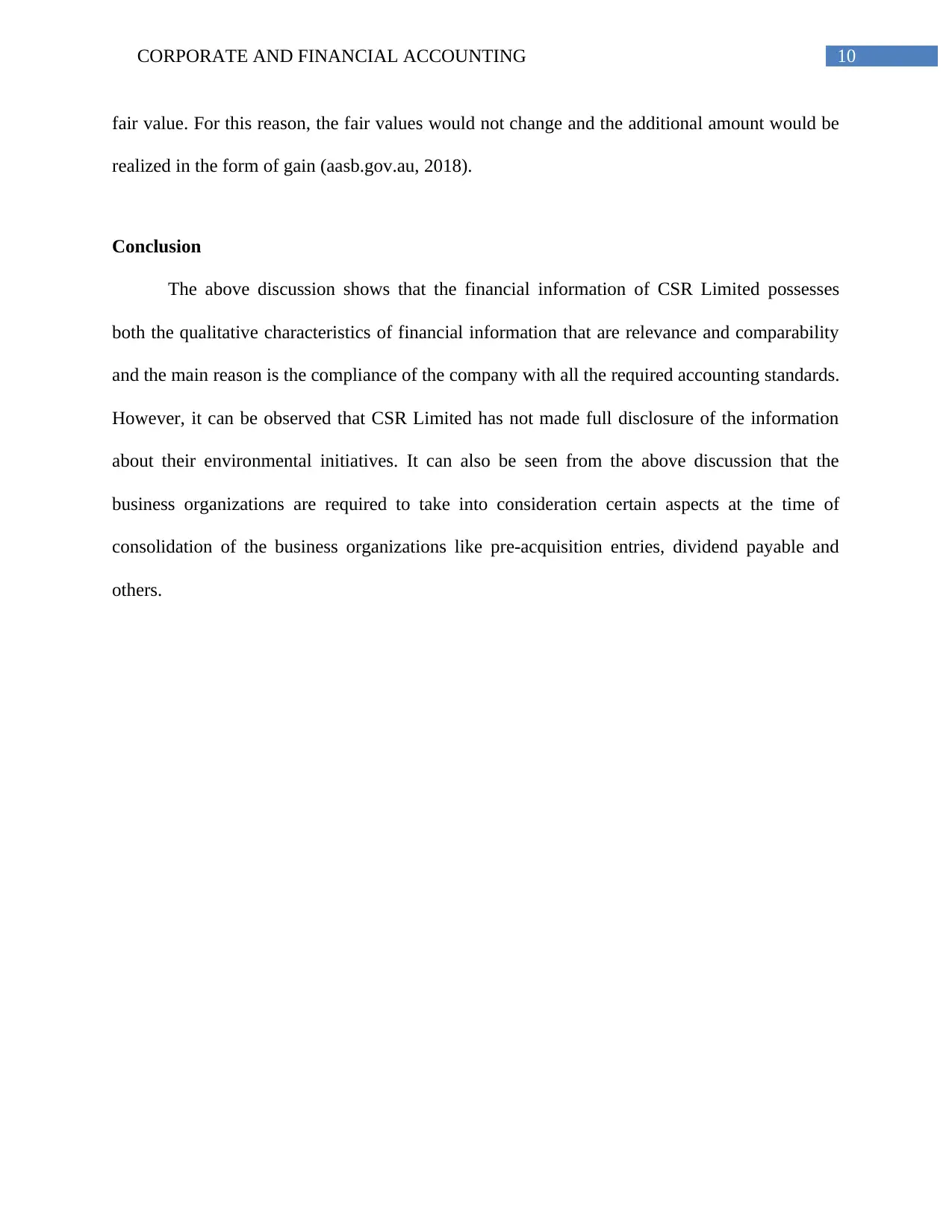
10CORPORATE AND FINANCIAL ACCOUNTING
fair value. For this reason, the fair values would not change and the additional amount would be
realized in the form of gain (aasb.gov.au, 2018).
Conclusion
The above discussion shows that the financial information of CSR Limited possesses
both the qualitative characteristics of financial information that are relevance and comparability
and the main reason is the compliance of the company with all the required accounting standards.
However, it can be observed that CSR Limited has not made full disclosure of the information
about their environmental initiatives. It can also be seen from the above discussion that the
business organizations are required to take into consideration certain aspects at the time of
consolidation of the business organizations like pre-acquisition entries, dividend payable and
others.
fair value. For this reason, the fair values would not change and the additional amount would be
realized in the form of gain (aasb.gov.au, 2018).
Conclusion
The above discussion shows that the financial information of CSR Limited possesses
both the qualitative characteristics of financial information that are relevance and comparability
and the main reason is the compliance of the company with all the required accounting standards.
However, it can be observed that CSR Limited has not made full disclosure of the information
about their environmental initiatives. It can also be seen from the above discussion that the
business organizations are required to take into consideration certain aspects at the time of
consolidation of the business organizations like pre-acquisition entries, dividend payable and
others.
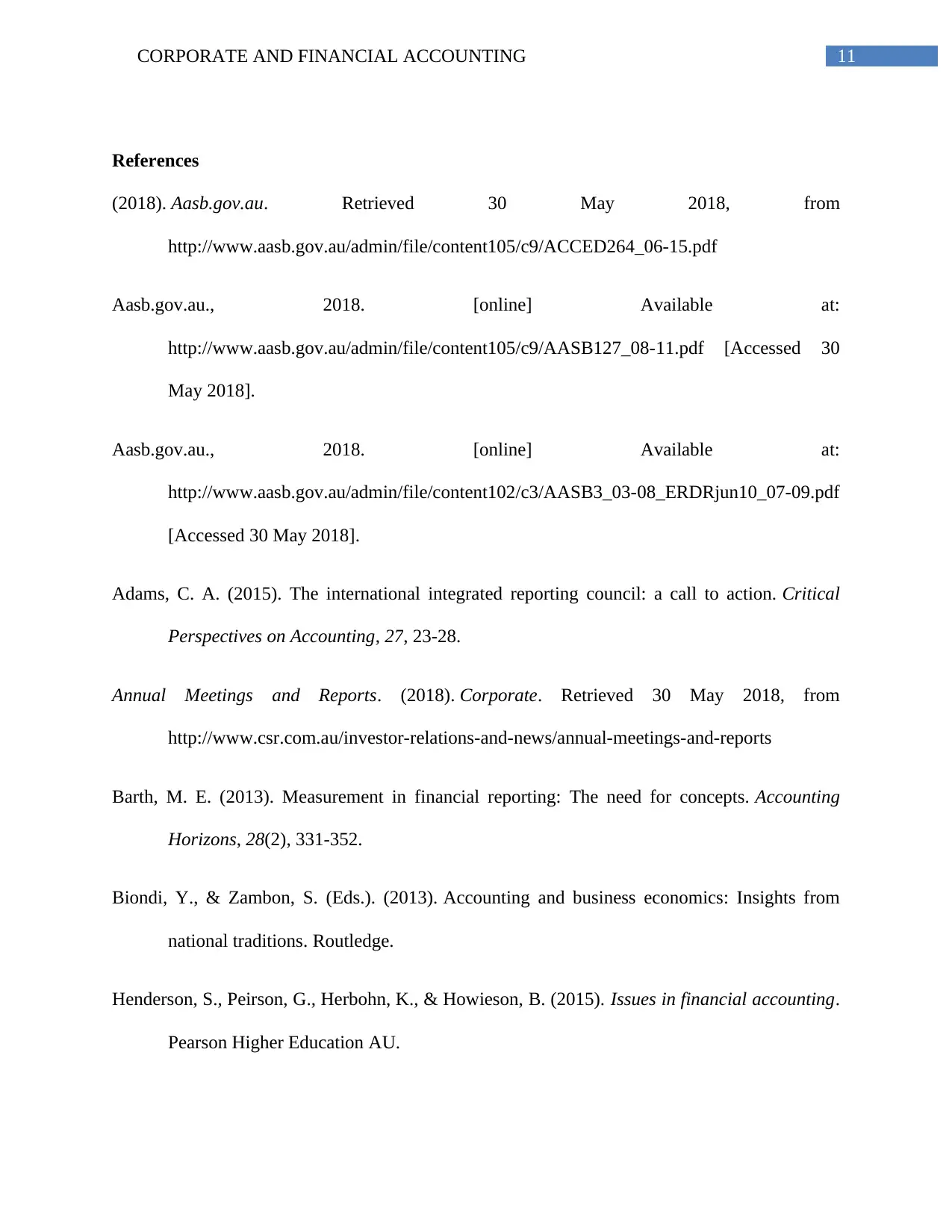
11CORPORATE AND FINANCIAL ACCOUNTING
References
(2018). Aasb.gov.au. Retrieved 30 May 2018, from
http://www.aasb.gov.au/admin/file/content105/c9/ACCED264_06-15.pdf
Aasb.gov.au., 2018. [online] Available at:
http://www.aasb.gov.au/admin/file/content105/c9/AASB127_08-11.pdf [Accessed 30
May 2018].
Aasb.gov.au., 2018. [online] Available at:
http://www.aasb.gov.au/admin/file/content102/c3/AASB3_03-08_ERDRjun10_07-09.pdf
[Accessed 30 May 2018].
Adams, C. A. (2015). The international integrated reporting council: a call to action. Critical
Perspectives on Accounting, 27, 23-28.
Annual Meetings and Reports. (2018). Corporate. Retrieved 30 May 2018, from
http://www.csr.com.au/investor-relations-and-news/annual-meetings-and-reports
Barth, M. E. (2013). Measurement in financial reporting: The need for concepts. Accounting
Horizons, 28(2), 331-352.
Biondi, Y., & Zambon, S. (Eds.). (2013). Accounting and business economics: Insights from
national traditions. Routledge.
Henderson, S., Peirson, G., Herbohn, K., & Howieson, B. (2015). Issues in financial accounting.
Pearson Higher Education AU.
References
(2018). Aasb.gov.au. Retrieved 30 May 2018, from
http://www.aasb.gov.au/admin/file/content105/c9/ACCED264_06-15.pdf
Aasb.gov.au., 2018. [online] Available at:
http://www.aasb.gov.au/admin/file/content105/c9/AASB127_08-11.pdf [Accessed 30
May 2018].
Aasb.gov.au., 2018. [online] Available at:
http://www.aasb.gov.au/admin/file/content102/c3/AASB3_03-08_ERDRjun10_07-09.pdf
[Accessed 30 May 2018].
Adams, C. A. (2015). The international integrated reporting council: a call to action. Critical
Perspectives on Accounting, 27, 23-28.
Annual Meetings and Reports. (2018). Corporate. Retrieved 30 May 2018, from
http://www.csr.com.au/investor-relations-and-news/annual-meetings-and-reports
Barth, M. E. (2013). Measurement in financial reporting: The need for concepts. Accounting
Horizons, 28(2), 331-352.
Biondi, Y., & Zambon, S. (Eds.). (2013). Accounting and business economics: Insights from
national traditions. Routledge.
Henderson, S., Peirson, G., Herbohn, K., & Howieson, B. (2015). Issues in financial accounting.
Pearson Higher Education AU.
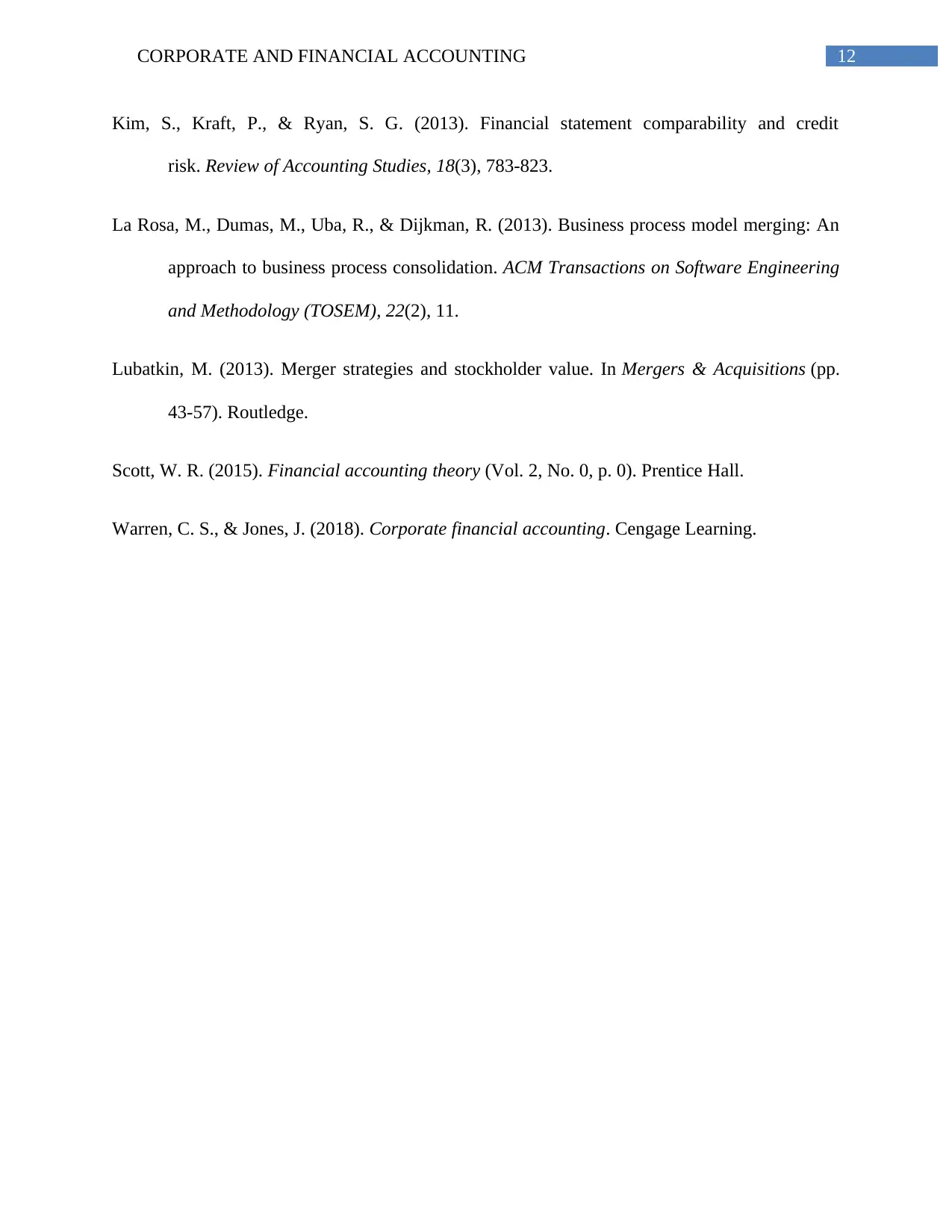
12CORPORATE AND FINANCIAL ACCOUNTING
Kim, S., Kraft, P., & Ryan, S. G. (2013). Financial statement comparability and credit
risk. Review of Accounting Studies, 18(3), 783-823.
La Rosa, M., Dumas, M., Uba, R., & Dijkman, R. (2013). Business process model merging: An
approach to business process consolidation. ACM Transactions on Software Engineering
and Methodology (TOSEM), 22(2), 11.
Lubatkin, M. (2013). Merger strategies and stockholder value. In Mergers & Acquisitions (pp.
43-57). Routledge.
Scott, W. R. (2015). Financial accounting theory (Vol. 2, No. 0, p. 0). Prentice Hall.
Warren, C. S., & Jones, J. (2018). Corporate financial accounting. Cengage Learning.
Kim, S., Kraft, P., & Ryan, S. G. (2013). Financial statement comparability and credit
risk. Review of Accounting Studies, 18(3), 783-823.
La Rosa, M., Dumas, M., Uba, R., & Dijkman, R. (2013). Business process model merging: An
approach to business process consolidation. ACM Transactions on Software Engineering
and Methodology (TOSEM), 22(2), 11.
Lubatkin, M. (2013). Merger strategies and stockholder value. In Mergers & Acquisitions (pp.
43-57). Routledge.
Scott, W. R. (2015). Financial accounting theory (Vol. 2, No. 0, p. 0). Prentice Hall.
Warren, C. S., & Jones, J. (2018). Corporate financial accounting. Cengage Learning.
1 out of 13
Related Documents
Your All-in-One AI-Powered Toolkit for Academic Success.
+13062052269
info@desklib.com
Available 24*7 on WhatsApp / Email
![[object Object]](/_next/static/media/star-bottom.7253800d.svg)
Unlock your academic potential
© 2024 | Zucol Services PVT LTD | All rights reserved.





